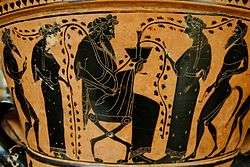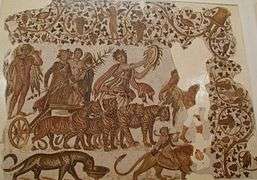Thiasus
In Greek mythology[1] and religion, the thiasus (Greek thiasos), was the ecstatic retinue of Dionysus, often pictured as inebriated revelers. Many of the myths of Dionysus are connected with his arrival in the form of a procession. The grandest such version was his triumphant return from "India", which influenced symbolic conceptions of the Roman triumph and was narrated in rapturous detail in Nonnus' Dionysiaca. In this procession, Dionysus rides a chariot, often drawn by big cats such as tigers, leopards, or lions.

The thiasos of the sea god Poseidon is depicted as a triumphal wedding procession with Amphitrite, attended by figures such as sea nymphs and hippocamps.
In historical Greek society, thiasoi (plural) were religious organizations whose existence was protected by law.[2]
Dionysian thiasos
The most significant members of the thiasus were the human female devotees, the maenads, who gradually replaced immortal nymphs. In Greek vase-paintings or bas-reliefs, lone female figures can be recognized as belonging to the thiasus by their brandishing the thyrsos, the distinctive staff or rod of the devotee.

Other regulars of the retinue were various nature spirits, including the sileni (or human dancers costumed as such), phalluses much in evidence, satyrs, and Pan. The ithyphallic sileni are often shown dancing on vase paintings.[3] The tutor of Dionysus is represented by a single aged Silenus. The retinue is sometimes shown being brought before a seated recipient: the tragic human welcomer of the gift of wine, Ikarios or Semachos, and his daughter, Erigone.[4] In the triumphal form of procession, Ariadne sometimes rides with Dionysus as his consort. Heracles followed the thiasus for a short while following his loss of a drinking contest to Dionysus.
On the 6th-century BC François Vase, Dionysus is accompanied in procession by the three Horae.[5] Other notable depictions in art include the silver "Great Dish" from the Mildenhall Treasure, the Lycurgus Cup, and in the Renaissance Titian's Bacchus and Ariadne. The Dionysian retinue was a popular subject for Roman art, especially bas-reliefs and sarcophagus panels.
Marine thiasos

A marine thiasos (or sea thiasos) is a term for a group like the Dionysian thiasos, except with the chief god replaced by Poseidon or some other sea deity.[6][7] Lattimore while insisting that the chief god must be Poseidon in a strict sense, includes examples where Poseidon is completely absent in the composition, which most frequently figure Tritons and Nereids as marine retinues.[6]
An original work of Skopas on this theme was taken to Rome and described by Pliny but is now lost.[8][7] Still, the theme is well represented in surviving works of Roman art, from tiny decorative reliefs and large sarcophagus panels to extensive mosaics.
Even in the Skopas example, the main theme was the deliverance of the slain Achilles to Elysium, attended by his mother Thetis (though Poseidon is present as well),[7] and examples of Thetis's retinue have been described as marine thiasos.[9]
The marine thiasos could otherwise be the retinue for Oceanus,[10] or to Venus Marina.[11]
Notes
- Karl Kerenyi, Dionysos: Archetypal image of indestructible life 1976:123, observes that "the ecstatic band of bacchantes and agitated male nature gods in a state of heightened zoë ... is not reflected in Minoan art."
- For example the thiasos in Athens examined by Marcus N. Tod, "A Statute of an Attic Thiasos", The Annual of the British School at Athens 13 (1906/07):328-338).
- Karl Kerenyi (Dionysos: Archetypal image of indestructible life 1976), selects as an example a 6th-century vase, figs 39/A and B.
- See Kerenyi 1976, ch. iv. "The Myths of Arrival".
- Detail illustrated in Kerenyi 1976 fig. 37.
- Lattimore, Steven (1976). The Marine Thiasos in Greek Sculpture. Institute of Archaeology, University of California, Los Angeles. p. 1.
The term 'marine thiasos' might be defined.. most correctly [as] a marine group.. attending the marine god, Poseidon, however.. may not always be depicted.
CS1 maint: ref=harv (link) - Papagiannaki, Anthousa (2014). Nereids and Hippocamps: The Marine Thiasos on Late Antique and Medieval Byzantine Ivory and Bone Caskets. The Legacy of Antiquity: New Perspectives in the Reception of the Classical World. Cambridge Scholars Publishing. pp. 73–74. ISBN 978-1-443-86774-0.CS1 maint: ref=harv (link)
- Lattimore (1976), pp. 13–
- South, Alison K. (1982), "Excavations at Kalavassos-Ayios Dhimitrios", Annual Report of the Director of the Department of Antiquities, Republic of Cyprus: 369CS1 maint: ref=harv (link)
- Toynbee, Jocelyn M. C. (1964). Art in Britain under the Romans. Clarendon Press. p. 309.CS1 maint: ref=harv (link), also quoted by Hutchinson, Valérie J. (1986), Bacchus in Roman Britain: the evidence for his cult, p. 286.
- Stirling, Lea Margaret (1994). Mythological statuary in late antiquity: a case study of villa decoration in southwest Gaul. University of Michigan. p. 109, n11. ISBN 978-1-443-86774-0.CS1 maint: ref=harv (link), citing Kaufmann-Heinimann (1984), pp.318–321.